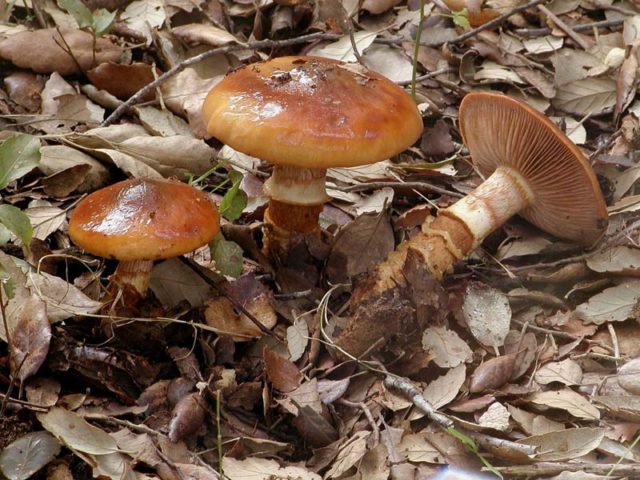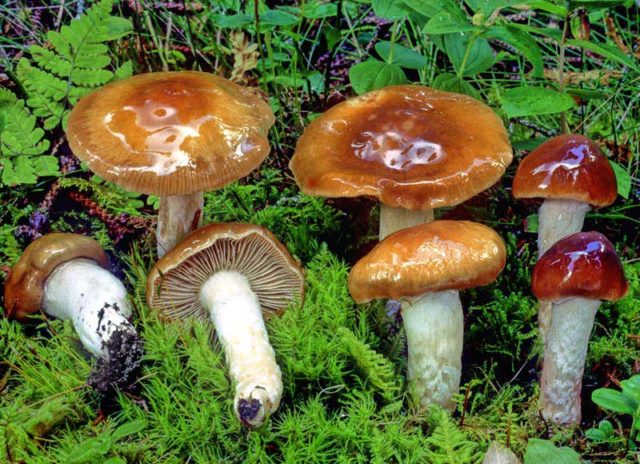Content
Common cobweb (lat. Cortinarius trivialis) is a small mushroom of the Cobweb family. It received its second name – Pribolotnik – for its preference for growing conditions. It is found in damp, swampy areas.
A detailed description of the common spiderwort with photos and videos is presented below.
Description of the common spider web
The fungus was named cobweb for its peculiar “veil” of cobwebby film present in young specimens. The rest of the appearance is unremarkable.
Description of the cap
The cap of the Marshweed is small: 3-8 cm in diameter. At the initial stage of development, it has the shape of a hemisphere, which later opens up.The color of the cap varies from pale yellow tones to ocher and light brown shades. The core is darker than the edges.
The cap is sticky to the touch and contains a small amount of mucus. The surface of the hymenophore is lamellar. In young fruiting bodies it is white, and in mature specimens it darkens to yellowish and brown tones.
The pulp is dense and fleshy, white, with a pungent odor.
Description of the leg
The leg is 6-10 cm in height, the diameter is 1.5-2 cm. Slightly narrowed towards the base. There are specimens with the opposite structure - there is a slight expansion at the bottom. The color of the legs is white, darkening closer to the ground to a brown tint. At the top of the cobwebby cover are brown concentric fibrous belts. From the middle of the legs to the base – weakly expressed.
Where and how does it grow
The swamp can be found under birch and aspen trees, and rarely under alder. Rarely lives in coniferous forests. Grows singly or in small groups in damp places.
In Russia, the distribution range of the species falls on the middle climatic zone.
Fruits from July to September.
Edible spider web or not
The nutritional properties of the common spiderwort have not been studied, but it is not an edible mushroom. This species should not be eaten.
Related specimens contain dangerous toxins in the pulp.
Symptoms of poisoning, first aid
The danger of toxic species of this family is that the first signs of poisoning appear gradually: up to 1-2 weeks after eating mushrooms. The symptoms look like this:
- strong thirst;
- nausea, vomiting;
- stomach ache;
- spasms in the lumbar region.
If you notice the first signs of poisoning, you should immediately consult a doctor or call an ambulance. Before receiving qualified treatment you need:
- rinse the stomach using activated charcoal;
- drink plenty of fluids (3-5 tbsp. boiled water in small sips);
- take a laxative to cleanse your intestines.
Doubles and their differences
The swamp grass is confused with other members of the family, as they are quite similar. The greatest similarity is noted with the mucous cobweb (lat. Cortinarius mucosus).
The cap is 5-10 cm in diameter. It has a thin edge and a thick center, abundantly covered with transparent mucus. The leg is slender, cylindrical, 6-12 cm long, 1-2 cm thick.
It differs from Pribolotnik in its abundant mucus and the shape of its cap.
Grows in coniferous and mixed forests under pine trees. Fruits singly.
The slimy cobweb (lat. Cortinarius mucifluus) is another twin of the Marshweed, which is also confused with the mucous cobweb due to its similar name. The cap with a diameter of 10-12 cm is abundantly covered with mucus. Leg 20 cm long in the form of a spindle, also covered in mucus. Prefers coniferous forests.
It differs from the Swampweed by its abundant mucus and longer stalk.
Conclusion
The common cobweb is an inedible mushroom; its properties have not been fully studied. Can be confused with other members of the family, the consumption of which is not recommended. The greatest similarity is noted with the mucous cobweb and the slime cobweb, but they can be distinguished by their cap. In the latter, it is abundantly covered with mucus.
Additional information about the common spiderwort:
















